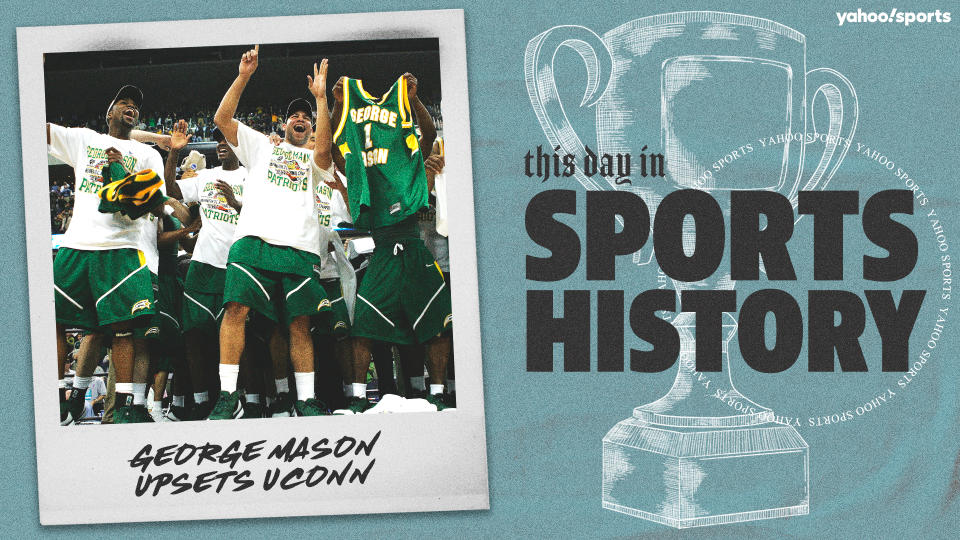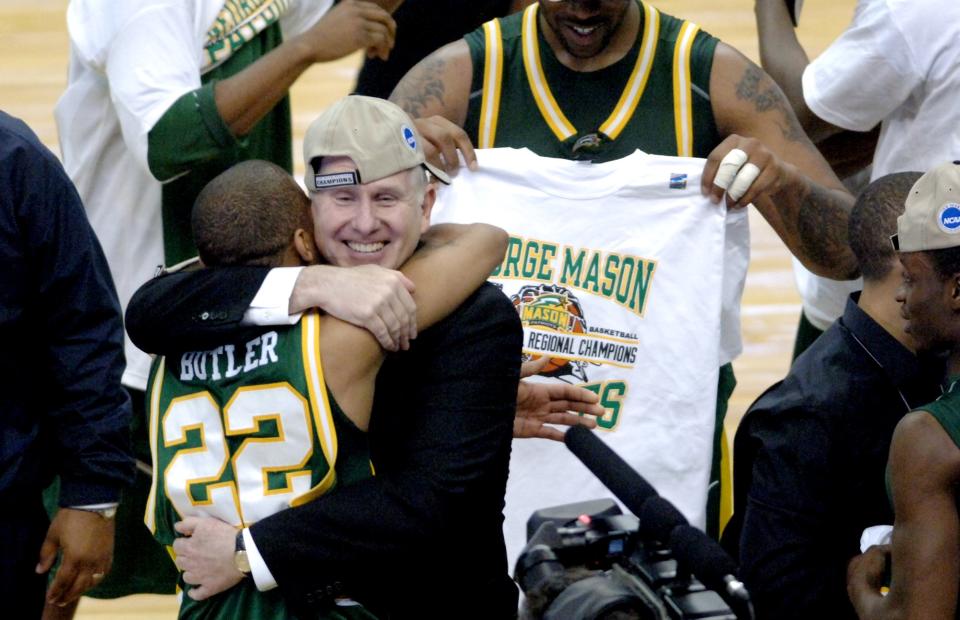Looking back at George Mason's historic Final Four run
Yahoo Sports is digging into the archives, taking a look back at the moments that shaped sports.
The beauty of the NCAA tournament is that every team — no matter the seed — has the chance to do something special.
Whether from the ACC, Big Ten or a conference you’ve never even heard of, each team starts from Square One with the dream of making a run deep into March.
And the 2006 edition of March Madness delivered one of the most improbable journeys in NCAA tournament history, culminating in a historic upset that took place on this day 14 years ago.
The George Mason University Patriots, a No. 11 seed out of the Colonial Athletic Association, advanced to the Final Four by knocking off mighty UConn, the tournament’s No. 1 overall seed, 86-84 in overtime.
With the win, George Mason tied the 1986 LSU Tigers as the lowest seed to ever reach the Final Four and cemented itself as the ultimate March Madness Cinderella story.

George Mason nearly missed the NCAA tournament
Entering the 2005-06 season, George Mason, located in Fairfax, Virginia, had never won a single NCAA tournament game in the history of its men’s basketball program. The Patriots had reached the tournament three times, bowing out in the first round in 1989, 1999 and 2001.
Two of those appearances came under head coach Jim Larranaga, who consistently had GMU in contention for the Colonial Athletic Association title. In 2006, the Patriots won a program-record 23 regular-season games en route to a CAA championship. But an NCAA tournament berth was suddenly in serious jeopardy when GMU lost to Hofstra in the semifinals of the CAA tournament.
There are typically very few mid-major teams who receive an at-large bid into the NCAA tournament, but George Mason ended up hearing its name called as the second team in from the CAA behind UNC Wilmington, which earned automatic entry by beating Hofstra in the tournament championship game.
George Mason’s place in the tournament was a source of controversy on Selection Sunday — the Patriots made it in over Hofstra, which beat GMU twice, and several high-major teams — but any questions over GMU’s place in the Field of 64 were soon erased.
David vs. Goliath
The Patriots opened tournament play by upsetting No. 6 seed Michigan State 75-65 in Dayton. Next was mighty defending national champion North Carolina, the Washington D.C. Region’s No. 3 seed led by future NBA first-round pick Tyler Hansbrough. George Mason would trail UNC by seven at halftime, before turning up the defensive pressure and dominating second-half play en route to a 65-60 win and a spot in the Sweet 16.
The Patriots then took down a fellow mid-major, No. 7 seed Wichita State (a team GMU beat on the road during the regular season), in the Sweet 16 to set up an Elite Eight matchup with 30-3 UConn, the No. 1 seed in the entire tournament.
The Huskies featured five future NBA players on their roster. That group included Rudy Gay, a 6-foot-8 sophomore who would be the No. 8 pick in the NBA draft just three months later.
UConn’s starting lineup also featured 6-foot-11 Hilton Armstrong and 6-foot-10 Josh Boone. Going against a George Mason team whose starting five of Jai Lewis, Tony Skinn, Lamar Butler, Will Thomas and Folarin Campbell topped out at 6-foot-7, the Huskies led by as many as 12 in the first half before going into the break with a 43-34 lead.
But the Patriots, playing a short drive from their campus, managed to claw their way back with tenacious rebounding and dead-eye 3-point shooting. At one point in the second half, GMU made six straight 3-point shots to flip a nine-point deficit into a two-point lead.
The George Mason lead was four with 23 seconds to play, but UConn would force overtime with two buckets in the final seven seconds of regulation. In overtime, however, GMU would finish the job and pull out a historic 86-84 victory. And despite UConn’s size advantage, GMU’s interior combo of Thomas and Lewis combined for 39 points and 19 rebounds and outplayed the future NBA duo of Boone and Armstrong (14 points, 9 rebounds combined). On the perimeter, Butler, Campbell and Skinn went for 19, 15 and 10 points, respectively, while connecting on 50 percent of their 3-pointers.

The impact of George Mason’s Final Four run
George Mason would see its miraculous run come to an end with a 73-58 loss to eventual national champion Florida (a team that featured Al Horford, Joakim Noah and Corey Brewer) in the next round, but that would not diminish the immense accomplishment by Larranaga’s group.
GMU would tie the 1986 LSU Tigers as the second No. 11 seed to move on to the Final Four (the 2011 VCU team would become the third, Loyola Chicago in 2018 became the fourth) and the lowest seed to ever advance that far in the NCAA tournament.
In the years that followed, George Mason seemed to lay out a blueprint of sorts for other mid-majors. It let teams like VCU (CAA), Davidson (Southern Conference), Butler (Horizon League), Wichita State (Missouri Valley Conference) and Loyola Chicago (MVC) know that you could make runs deep into the NCAA tournament — no matter what conference you came from.
More from Yahoo Sports: